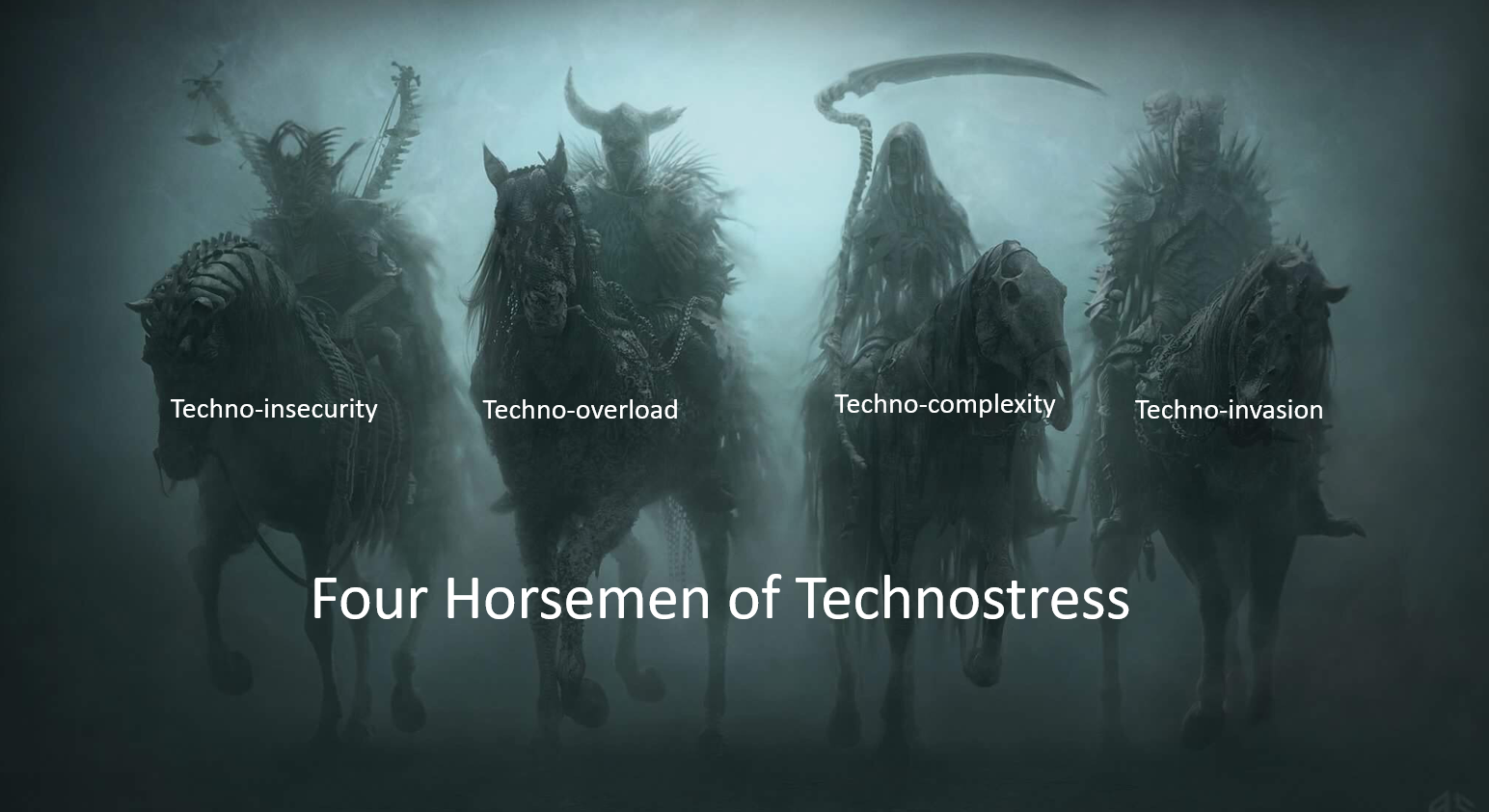Stress is a fact of life in our adversarial legal system. Technostress is the ‘negative psychological link between people and the introduction of new technologies’. Now that many or most digital professionals semi-permanently work from home (WFH) the potential for the four technostress horsemen of the coronapocalypse are increasingly impacting our lives. Let’s meet the primary digital stressors in preliminary academic impact priority that cost between $221 million and $187 billion annually:
- “Techno-insecurity” is associated with situations where people feel threatened about losing their jobs to other people who have a better understanding of new gadgets and computing devices.
- “Techno-overload” describes situations where use of computers forces people to work more and work faster.
- “Techno-complexity” describes situations where the complex computer systems used at work force people to spend time and effort in learning and understanding how to use new applications and to update their skills. People find the variety of applications, functions, and jargon intimidating and consequently feel stressed.
- “Techno-invasion” describes being “always exposed” where people can potentially be reached anywhere and any time and feel the need to be constantly connected. The regular work-day is extended, office work is done at all sorts of hours, and it is almost impossible to “cut away.”

I have spent a lot of time recently researching the impact and factors of techno-complexity, especially in the professional services verticals. My thanks to the execs, PMs and consultants who have taken my survey and interviews. Even before the pandemic-forced WFH wave some studies found that employees were switching apps more than 1,100 times a day. The managed service and contract professional trends mean that many of us are tabbing between multiple M365 accounts, Slack instances and other collaboration feeds to keep up with projects, clients and peers. This constant game of digital Whack-a-Mole kills productivity and increases the risk of dropped balls.
My personal interpretation is that every hop between platforms or feed checks breaks your productive ‘flow’. If we think of the human brain in techno-terms, you have to dump and reload your mental RAM with every topic switch. Microsoft’s cheery daily Viva Insight email reminds you to ‘book focus time’ to lock down time away from distractions and alerts. Even when I am in full research mode for a blog like this I am constantly running searches, extracting content from different sources and hitting ALT-TAB more than I want to acknowledge. Most of the consolidation hub or project/task management platforms I have been testing either migrate/reprocess my existing feeds or essentially create a whole new content repository. I have found some productivity and stress reduction from consciously reorganizing my digital content siloes and trimming back apps that overlap functionality. A good example of this is my realization that I was flagging emails for follow up in Outlook, managing project tasks in Planner and responding to client Jira tasks. I have forced myself to consolidate my tasks and set up Power Automate rules to create tasks from external emails by rule. It feels kind of Rube Goldberg, but I can at least see all my outstanding deliverables in one place. That definitely reduced my stress. Do you have trick for managing your techno-complexity? I would love to hear about it.
Greg Buckles wants your feedback, questions or project inquiries at Greg@eDJGroupInc.com. Contact him directly for a free 15 minute ‘Good Karma’ call. He solves problems and creates eDiscovery solutions for enterprise and law firm clients.
Greg’s blog perspectives are personal opinions and should not be interpreted as a professional judgment or advice. Greg is no longer a journalist and all perspectives are based on best public information. Blog content is neither approved nor reviewed by any providers prior to being published. Do you want to share your own perspective? Greg is looking for practical, professional informative perspectives free of marketing fluff, hidden agendas or personal/product bias. Outside blogs will clearly indicate the author, company and any relevant affiliations.
See Greg’s latest pic on Instagram.
